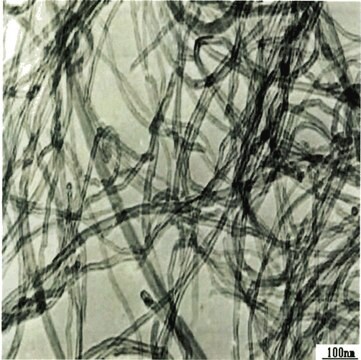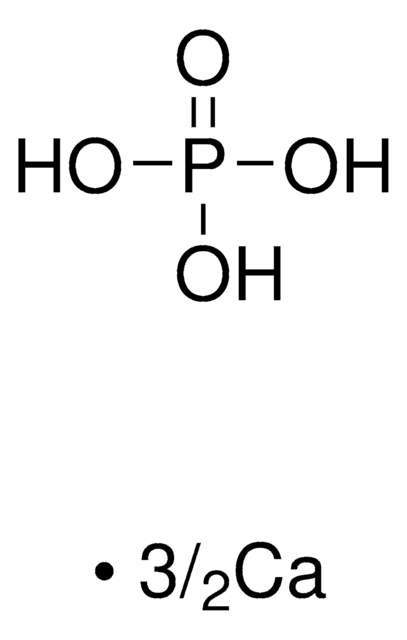702153
Hydroxyapatite
nanoparticles, dispersion, 10 wt. % in H2O, <200 nm particle size (BET)
Sinónimos:
Calcium hydroxide phosphate, Calcium hydroxylapatite, Calcium hydroxyphosphate, Nano hydroxyapatatite, Pentacalcium hydroxide triphosphate
About This Item
Productos recomendados
formulario
dispersion
nanoparticles
Nivel de calidad
contiene
≤0.025 wt. % dispersant (non-metal based)
concentración
10 wt. % in H2O
superficie
14.3 m2/g , typical
tamaño de partícula
<200 nm (BET)
pH
4-6
densidad
1.038 g/mL at 25 °C
cadena SMILES
[Ca++].[Ca++].[Ca++].[Ca++].O[Ca+].[O-]P([O-])([O-])=O.[O-]P([O-])([O-])=O.[O-]P([O-])([O-])=O
InChI
1S/5Ca.3H3O4P.H2O/c;;;;;3*1-5(2,3)4;/h;;;;;3*(H3,1,2,3,4);1H2/q5*+2;;;;/p-10
Clave InChI
XYJRXVWERLGGKC-UHFFFAOYSA-D
¿Está buscando productos similares? Visita Guía de comparación de productos
Descripción general
Aplicación
- An implant material for bone substitute due to its chemical similarity to the inorganic component of bone and osteo inductive properties.
- A vehicle for gene and drug delivery because of its encapsulation capacity and affinity to several drugs and proteins.
- A pH responsive particulate emulsifier.
Características y beneficios
- Biocompatible
- Osteoconductive
- Stable under physiological conditions
- High mechanical strength
Información legal
Código de clase de almacenamiento
12 - Non Combustible Liquids
Clase de riesgo para el agua (WGK)
WGK 1
Punto de inflamabilidad (°F)
Not applicable
Punto de inflamabilidad (°C)
Not applicable
Elija entre una de las versiones más recientes:
¿Ya tiene este producto?
Encuentre la documentación para los productos que ha comprado recientemente en la Biblioteca de documentos.
Los clientes también vieron
Artículos
Dendrimers are just one class of nano-sized materials that are explored to develop new life-saving technologies. Single-wall carbon nanotubes are used to make miniaturized sensors for DNA, pathogens, and chemicals – for example glucose sensors. Multi-wall nanotubes, nanoclays, and ceramic nanoparticles are incorporated in ultra-strong polymer nanocomposites that will be used in orthopedic, for example joint-replacement, applications.
A key challenge for nanomaterial safety assessment is the ability to handle the large number of newly engineered nanomaterials (ENMs), including developing cost-effective methods that can be used for hazard screening.
Nuestro equipo de científicos tiene experiencia en todas las áreas de investigación: Ciencias de la vida, Ciencia de los materiales, Síntesis química, Cromatografía, Analítica y muchas otras.
Póngase en contacto con el Servicio técnico









